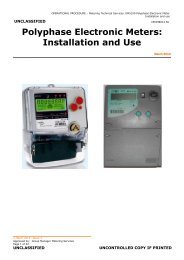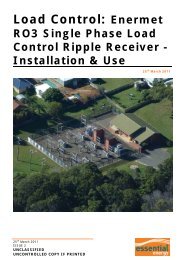Elster LCR-212 Single Phase Load Control ... - Essential Energy
Elster LCR-212 Single Phase Load Control ... - Essential Energy
Elster LCR-212 Single Phase Load Control ... - Essential Energy
Create successful ePaper yourself
Turn your PDF publications into a flip-book with our unique Google optimized e-Paper software.
UNCLASSIFIED<br />
OPERATIONAL PROCEDURE - <strong>Elster</strong> <strong>LCR</strong>-<strong>212</strong> <strong>Single</strong> <strong>Phase</strong><br />
<strong>Load</strong> <strong>Control</strong> Ripple Receiver Installation and<br />
Use<br />
CEOP8086<br />
4 RECEIVER FUNCTIONS<br />
4.1 Switching On/Off<br />
When defining the parameters, the switch-on status can be specified separately for each<br />
relay. The execution of switch-ON operations in the receiver can be delayed within a<br />
maximum random delay time in the range from 1 second – 24 hours.<br />
4.2 Restoration of Supply<br />
This function is activated when power is restored, following programming, or when the<br />
mains is connected for the first time. The following actions can be programmed separately<br />
for each of the three relays:<br />
• ON or OFF relay status<br />
• Cyclic switching<br />
• Switching to the relay state prevailing before failure of the mains power<br />
• No reaction.<br />
To avoid abrupt load swings, execution of the switching functions can be randomly delayed<br />
within a preset maximum time. The selected delay time is identical for all three relays and<br />
can be chosen within a range from 1 second – 24 hours.<br />
If the receiver executes a delay when the mains power returns, then commands arriving<br />
during this delay time are acted on and the ROS reaction of the relays addressed is<br />
rendered inactive.<br />
4.3 Loss of Supply<br />
This function is activated in the event of a power failure. It is possible to set the relays to a<br />
preselected switching position after expiry of a definable power failure bridging time of 0.5 –<br />
1.5 seconds.<br />
The following actions can be assigned to the relays after the failure bridging time has<br />
elapsed:<br />
• ON or OFF relay status<br />
• No action<br />
4.4 Wiping Timer<br />
After reception of a command, the addressed relay switches to the ON position and then<br />
independently switches to the OFF position after expiry of a specified time. It is possible to<br />
retrigger the wiping timer function, i.e. the running timer is restarted on receipt of a<br />
repeated command.<br />
A delay time of 1 second – 24 hours and a random delay time can be assigned for execution<br />
of the command.<br />
4.5 Cyclic Switching<br />
A cyclic switching function can be assigned to relays 1 – 3. The cyclic period T applies to all<br />
relays and can be specified within the range of 1 second - 24 hours. The following features<br />
can also be assigned to each cyclic switching command:<br />
• cycle time Tk (ON duration) within the time range from 1 second – 24 hours<br />
• number of switching cycles<br />
• start of switching at cycle time Tk or T – Tk<br />
22 March 2011 - Issue 3<br />
Approved By: General Manager Technical Services<br />
Page 9 of 17<br />
UNCLASSIFIED<br />
UNCONTROLLED COPY IF PRINTED
















